Emily Guo
user_sophia9212
Emily Guo
user_sophia9212
Introduction to Chinese Music and Painting
This AP Chinese guide covers the history of Chinese music and painting in regards to personal and public identities. For example, learning and playing traditional Chinese instruments has become an important part of many people’s personal identities while historical Chinese landscape paintings are a record of Chinese people’s shared public identity.
Chinese Music
Traditional Chinese Music
Chinese traditional music is a type of music that has been played in China for centuries. It includes a wide variety of musical styles and genres, each with its own unique sound and cultural significance.
One of the most well-known forms of Chinese traditional music is Chinese classical music, which includes instruments like the 二胡(èrhú), 琵琶(pípá), and 笛子(dízi). This music is often played in orchestras and is known for its complex melodies and intricate compositions.
Another popular form of Chinese traditional music is Chinese folk music, which includes a variety of styles and instruments from different regions of China. Folk music in China often reflects the cultural and historical traditions of the area where it is played. For example, the music of the Miao people in southwestern China is known for its unique melodies and instrumentation, while the music of the Mongolian people in northern China is characterized by its throat singing and horse-head fiddle.
Chinese traditional music also includes a wide range of opera styles, including Beijing opera, which is known for its colorful costumes and elaborate makeup, and Kunqu opera, which is known for its refined melodies and poetic lyrics.
Traditional Chinese Instruments
In Chinese history, the earliest musical instruments found are estimated to be from 9,000 years ago. Musicians were seen to have a low social status while still being vital to the dynasties. Chinese instruments are grouped into categories called 八音(bā yīn): Silk, Bamboo, Wood, Stone, Metal, Clay, Gourd, and Skin. Within the silk category, instruments can usually be split into plucked, bowed, and struck categories for playing. China has many traditional musical instruments including the 二胡(èrhú), 古筝(gǔzhēng), 琵琶(pípá), 笛子(dízi), and the 萧(xiāo).
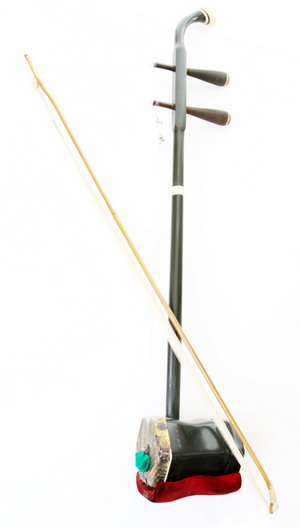
Image Courtesy of Wikimedia Commons
The 二胡 is made of two strings (bowed silk instrument), and because of its size and cost, very popular among current street musicians while still being used in performances such as Chinese operas.
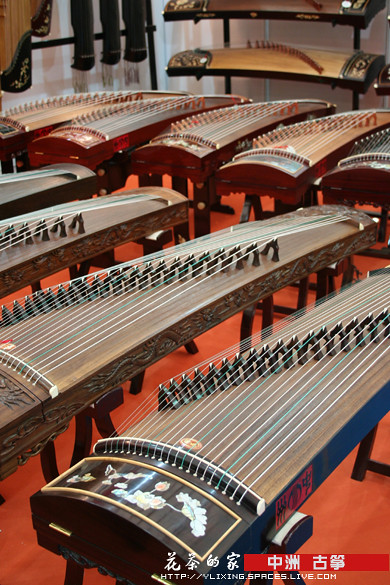
Image Courtesy of Flickr
The 古筝 is a (silk instrument) plucked zither with usually 21, 25, or 26 strings. It's usually played in traditional music performances. Players will sit in chairs in front of the 古筝, which is placed on a desk.
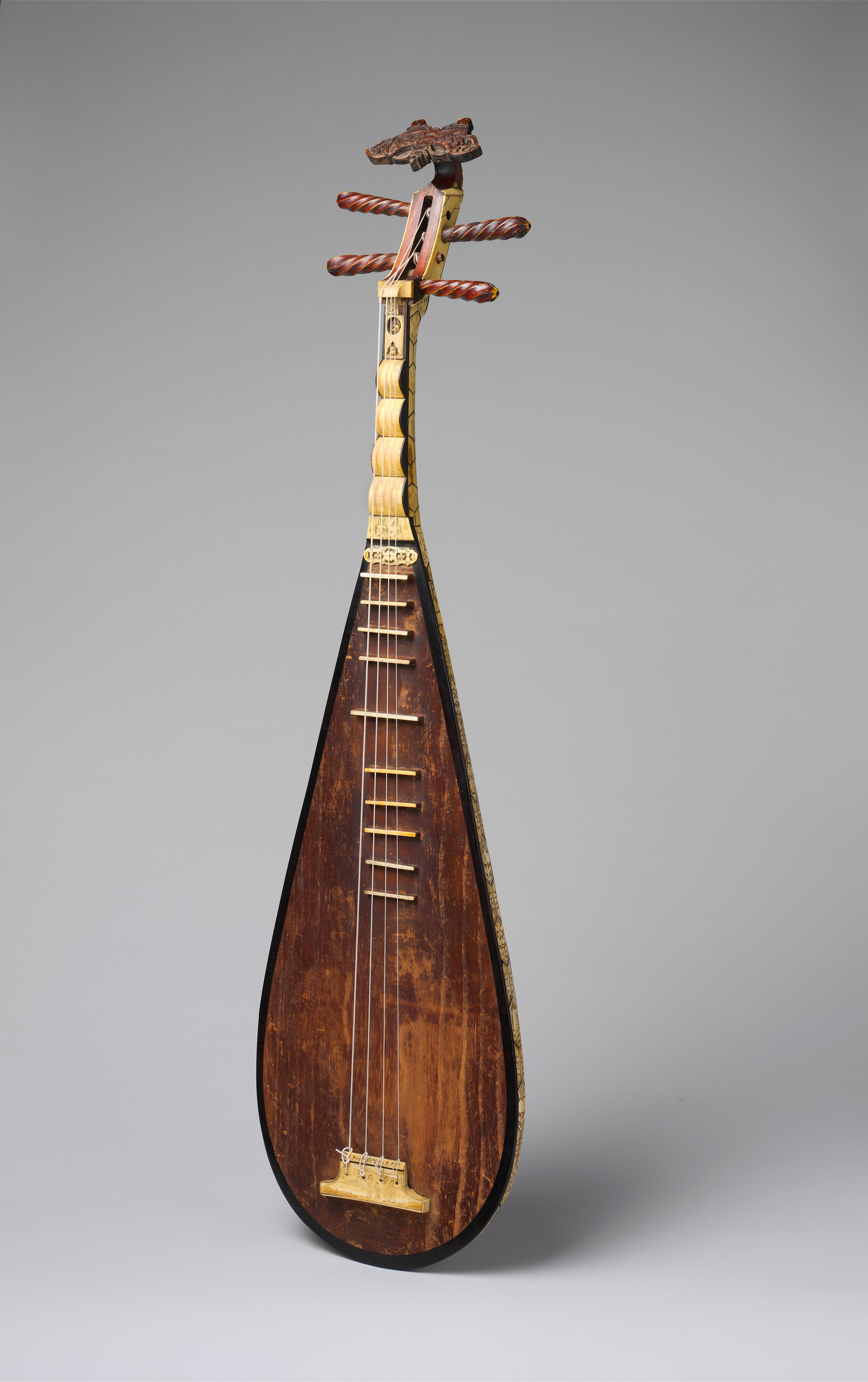
Image Courtesy of Wikimedia Commons
The 琵琶 is another silk instrument falling into the plucked category of instruments. With 4 strings and a pear-shaped body, the 琵琶 is thought to have originated during the Han dynasty (202 BCE-220 CE). It's usually played in an upright position.
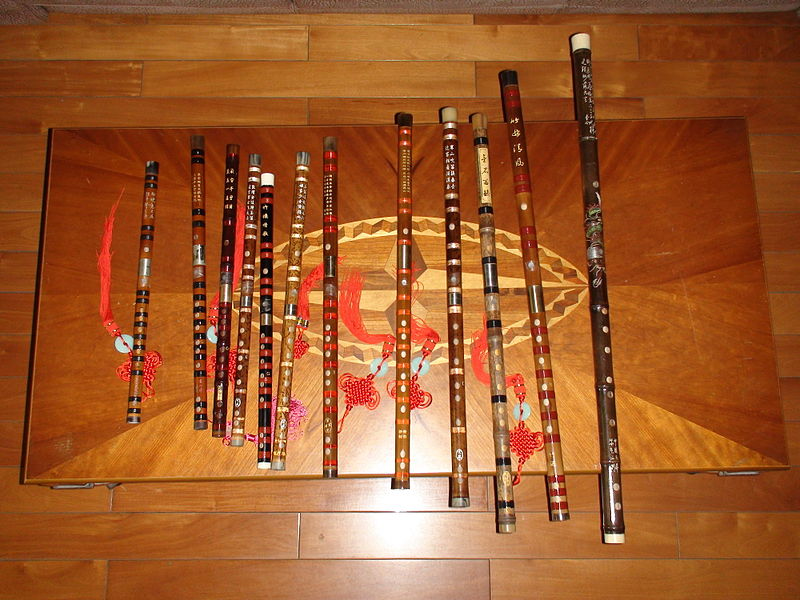
Image Courtesy of Wikimedia Commons
The 笛子 is a transverse bamboo flute. Original flutes are shown to have originated about 7,000 BCE, but the modern 笛子 comes from roughly the 5th century BCE. Usually with 6 or more holes, the 笛子 is light and easy to carry. One of the holes has a membrane called a 笛膜(dí mó) (made from reed) covering it to produce a specific buzzing sound.
The 萧 (also known as 洞箫(dòngxiāo)) ****is a vertically blown bamboo flute. The blowing hole is usually cut into a U or V shape with the player blowing air over it.
Modern Music
In recent years, the most popular genres of music in China include C-pop (Chinese popular music), hip hop, rock music, and music from other countries. Some of the most popular artists include 薛之谦, 周杰伦, 邓紫棋 (G.E.M.), 毛不易, and the group TFBoys. Many modern Chinese popular songs include some English lyrics mixed in with Mandarin.
Related Vocabulary
- 博物馆(bówùguǎn)- Museum
- 紫禁城(zǐjìnchéng)- The Forbidden City
- 故宫博物院(gùgōng bówùyuàn)- Palace Museum
- 秦始皇兵马俑(qínshǐhuáng bīngmǎyǒng)- Terracotta Army Museum
- 中国国家博物馆(zhōngguó guójiā bówùguǎn)- National Museum of China
- 音乐(yīnyuè)- Music
- 汉语流行音乐(hànyǔ liúxíng yīnyuè)- Chinese Popular Music (C-pop)
- 嘻哈音乐(xīhā)- Hip Hop Music
- 说唱(shuōchàng)- Rap Music
- 摇滚音乐(yáogǔn yīnyuè)- Rock Music
Chinese Paintings
History of Traditional Chinese Paintings
The style of paintings in China 🇨🇳 can reflect the dynasty in which it was created and tell stories from history.
From the Han Dynasty, paintings were used to decorate the halls of buildings including tombs. During the Six Dynasties (Three Kingdoms, Jin Dynasty, and the Southern and Northern Dynasties), painting was mostly done through calligraphy. Then, during the Tang Dynasty, paintings of court life displaying people began to pop up. Starting around this time, ink paintings began to be accepted as fully finished paintings.
Landscape paintings also gained traction during this time period, especially those where slight color was added. Landscape painting in China has a long and storied history, and is known for its beautiful and intricate compositions that depict the natural beauty of the country's landscapes. In the following eras, from the Yuan Dynasty with the Mongols taking over China, with the disappearance of many artists choosing to not follow the Mongols, which is reflected in the artworks from that time to modern China, where many artists are influenced by aspects of Western culture in their paintings.
.jpg)
Image from Wikimedia Commons
This painting displayed above is called "Along the River During the Qingming Festival" or 清明上河图. It displays the normal everyday lives of citizens during the Song dynasty. It is one of the most famous Chinese paintings to date. As you can see, painting was used to illustrate the daily life of historical Chinese 🇨🇳 citizens as well as stories in history.
The evolution of painting, as well as the changes in what is depicted, can record history. In China, the earliest paintings were images of figures and landscapes. Silk paintings, stone paintings, and other lacquer paintings were most common until the invention of paper.

Image Courtesy of Wikimedia Commons
Paintings of landscapes became popular and advanced to show 3D effects during the Tang dynasty. Landscape paintings (山水画(shānshuǐhuà)), much like the one shown above, were meant to be depicting feelings and emotions of nature, rather than an accurate depiction of the landscape. Paintings were made using brushes and ink.

Image Courtesy of Wikimedia Commons
Paintings during the Song dynasty evolved into more faded and blurred images. A large impact was made due to religion: Daoism and Buddhism. During the Northern Song period, many paintings were affected by the politics of the time with large-scale reform ideals, causing them to depict large landscapes. The image above is from the Northern Song period.
In comparison, during the Southern Song period, many paintings were influenced by ideals of smaller-scale reforms, causing them to be detail-oriented with the forefront of the painting being the highlight. Religious aspects from Daoism to Neo-Confucianism shaped this period of change in both political ideals and the paintings made.

Image Courtesy of Wikimedia Commons
During the Yuan dynasty, many paintings began to reflect what the painter felt in the moment, rather than the feelings of the surroundings. Because of the conquest of the Mongols, paintings also began to revert to much older and painting styles to keep a Chinese tradition in lieu of the Mongols presence in China as in the image above.
Many Chinese artists and scholars chose to return to life away from the court because of an unwillingness to participate in the government while it's ruled by outsiders. Many Mongols chose to blend into Chinese culture, therefore not having a large effect on the styles of the paintings, however, more horse paintings in hunting and racing appeared due to the nomadic nature of the Mongols.
Image Courtesy of Wikimedia Commons
In the Ming dynasty, the colors used in paintings were expanded and specific painted instructions on painting were developed. These instruction manuals are, in fact, still in use today. An example is the Manual of the Mustard Seed Garden (芥子园画传(jièzǐ yuán huà zhuán)), shown above, which was published in 1679 and contains 5 volumes.

Image Courtesy of Wikimedia Commons
During the Qing dynasty, two painting styles emerged: Orthodox Painting and Individualistic Painting. Both were derived from the theories of 董其昌(dǒngqíchāng). The Orthodox painting style involved mostly recreations of older styles. In comparison, individualistic paintings were made to be purposely different from past styles. The painting above is one made during the Qing dynasty.
Related Vocabulary
- 清明上河图(qīngmíng shànghé tú)- Along the River During the Qingming Festival
- 山水画(shānshuǐhuà)- Landscape painting
- 芥子园画传(jièzǐ yuán huà zhuán)- Manual of the Muster Seed Garden
- 毛笔(máobǐ)- Ink Brush
- 墨水(mòshuǐ)- Ink
- 色彩(sècǎi)- Color
- 绢画(juàn huà)- Silk Painting
- 石画(shí huà)- Stone Painting
- 漆器(qīqì)- Lacquerware
Street Art in Modern China
Street art around the world has been increasing in numbers, not just in China. At the moment, graffiti is considered illegal as it is said to be vandalism. However, in many large cities in China, the amount of street art continues to grow. Influences of the West is said to be the biggest driving factor of street art. Along with many annual events supporting the growing community of street art in China, commercial graffiti has also come along, offering a way for street artists to make a living.
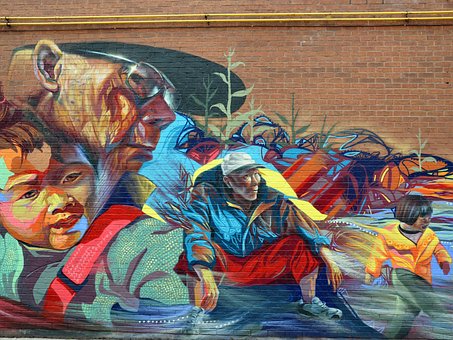
Image Courtesy of Pixabay
Street artists usually focus on certain aspects related to their interests. For example, one street artist Daboo does street art corresponding to hip hop culture, making his street art narrow in on music, DJ, break dancing, and graffiti.
Along with modern street art, history has its own street art. Back in the 16th century, many women covered the sides of the Great Wall of China with decorations of clouds, lotus blossoms, and other symbols to hope for the safe return of their husbands from war. Going to the 1920s, while China was going through its own reforms, propaganda, political slogans, and more made their way to many public areas.
Related Vocabulary
- 艺术(yìshù)- Art
- 街头艺术(jiētóu yìshù)- Street Art
- 涂鸦(túyā)- Graffiti
- 破坏(pòhuài)- To Damage
- 非法(fēifǎ)- Illegal
- 商业涂鸦(shāngyè túyā)- Commercial Graffiti
- 兴趣(xìngqù)- Interest
- 兴趣爱好(xìngqù àihào)- Hobby
- 嘻哈(xīhā)- Hip Hop
- (万里)长城((wànlǐ) chángchéng)- The Great Wall of China
- 云(朵)(yún (duǒ))- Clouds
- 荷花(héhuā)- Lotus Blossoms
- 战争(zhànzhēng)- War
- 宣传(xuānchuán)- Propaganda
- 政治口号(zhèngzhì kǒuhào)- Political Slogans
<< Hide Menu
Emily Guo
user_sophia9212
Emily Guo
user_sophia9212
Introduction to Chinese Music and Painting
This AP Chinese guide covers the history of Chinese music and painting in regards to personal and public identities. For example, learning and playing traditional Chinese instruments has become an important part of many people’s personal identities while historical Chinese landscape paintings are a record of Chinese people’s shared public identity.
Chinese Music
Traditional Chinese Music
Chinese traditional music is a type of music that has been played in China for centuries. It includes a wide variety of musical styles and genres, each with its own unique sound and cultural significance.
One of the most well-known forms of Chinese traditional music is Chinese classical music, which includes instruments like the 二胡(èrhú), 琵琶(pípá), and 笛子(dízi). This music is often played in orchestras and is known for its complex melodies and intricate compositions.
Another popular form of Chinese traditional music is Chinese folk music, which includes a variety of styles and instruments from different regions of China. Folk music in China often reflects the cultural and historical traditions of the area where it is played. For example, the music of the Miao people in southwestern China is known for its unique melodies and instrumentation, while the music of the Mongolian people in northern China is characterized by its throat singing and horse-head fiddle.
Chinese traditional music also includes a wide range of opera styles, including Beijing opera, which is known for its colorful costumes and elaborate makeup, and Kunqu opera, which is known for its refined melodies and poetic lyrics.
Traditional Chinese Instruments
In Chinese history, the earliest musical instruments found are estimated to be from 9,000 years ago. Musicians were seen to have a low social status while still being vital to the dynasties. Chinese instruments are grouped into categories called 八音(bā yīn): Silk, Bamboo, Wood, Stone, Metal, Clay, Gourd, and Skin. Within the silk category, instruments can usually be split into plucked, bowed, and struck categories for playing. China has many traditional musical instruments including the 二胡(èrhú), 古筝(gǔzhēng), 琵琶(pípá), 笛子(dízi), and the 萧(xiāo).

Image Courtesy of Wikimedia Commons
The 二胡 is made of two strings (bowed silk instrument), and because of its size and cost, very popular among current street musicians while still being used in performances such as Chinese operas.

Image Courtesy of Flickr
The 古筝 is a (silk instrument) plucked zither with usually 21, 25, or 26 strings. It's usually played in traditional music performances. Players will sit in chairs in front of the 古筝, which is placed on a desk.

Image Courtesy of Wikimedia Commons
The 琵琶 is another silk instrument falling into the plucked category of instruments. With 4 strings and a pear-shaped body, the 琵琶 is thought to have originated during the Han dynasty (202 BCE-220 CE). It's usually played in an upright position.

Image Courtesy of Wikimedia Commons
The 笛子 is a transverse bamboo flute. Original flutes are shown to have originated about 7,000 BCE, but the modern 笛子 comes from roughly the 5th century BCE. Usually with 6 or more holes, the 笛子 is light and easy to carry. One of the holes has a membrane called a 笛膜(dí mó) (made from reed) covering it to produce a specific buzzing sound.
The 萧 (also known as 洞箫(dòngxiāo)) ****is a vertically blown bamboo flute. The blowing hole is usually cut into a U or V shape with the player blowing air over it.
Modern Music
In recent years, the most popular genres of music in China include C-pop (Chinese popular music), hip hop, rock music, and music from other countries. Some of the most popular artists include 薛之谦, 周杰伦, 邓紫棋 (G.E.M.), 毛不易, and the group TFBoys. Many modern Chinese popular songs include some English lyrics mixed in with Mandarin.
Related Vocabulary
- 博物馆(bówùguǎn)- Museum
- 紫禁城(zǐjìnchéng)- The Forbidden City
- 故宫博物院(gùgōng bówùyuàn)- Palace Museum
- 秦始皇兵马俑(qínshǐhuáng bīngmǎyǒng)- Terracotta Army Museum
- 中国国家博物馆(zhōngguó guójiā bówùguǎn)- National Museum of China
- 音乐(yīnyuè)- Music
- 汉语流行音乐(hànyǔ liúxíng yīnyuè)- Chinese Popular Music (C-pop)
- 嘻哈音乐(xīhā)- Hip Hop Music
- 说唱(shuōchàng)- Rap Music
- 摇滚音乐(yáogǔn yīnyuè)- Rock Music
Chinese Paintings
History of Traditional Chinese Paintings
The style of paintings in China 🇨🇳 can reflect the dynasty in which it was created and tell stories from history.
From the Han Dynasty, paintings were used to decorate the halls of buildings including tombs. During the Six Dynasties (Three Kingdoms, Jin Dynasty, and the Southern and Northern Dynasties), painting was mostly done through calligraphy. Then, during the Tang Dynasty, paintings of court life displaying people began to pop up. Starting around this time, ink paintings began to be accepted as fully finished paintings.
Landscape paintings also gained traction during this time period, especially those where slight color was added. Landscape painting in China has a long and storied history, and is known for its beautiful and intricate compositions that depict the natural beauty of the country's landscapes. In the following eras, from the Yuan Dynasty with the Mongols taking over China, with the disappearance of many artists choosing to not follow the Mongols, which is reflected in the artworks from that time to modern China, where many artists are influenced by aspects of Western culture in their paintings.
.jpg)
Image from Wikimedia Commons
This painting displayed above is called "Along the River During the Qingming Festival" or 清明上河图. It displays the normal everyday lives of citizens during the Song dynasty. It is one of the most famous Chinese paintings to date. As you can see, painting was used to illustrate the daily life of historical Chinese 🇨🇳 citizens as well as stories in history.
The evolution of painting, as well as the changes in what is depicted, can record history. In China, the earliest paintings were images of figures and landscapes. Silk paintings, stone paintings, and other lacquer paintings were most common until the invention of paper.

Image Courtesy of Wikimedia Commons
Paintings of landscapes became popular and advanced to show 3D effects during the Tang dynasty. Landscape paintings (山水画(shānshuǐhuà)), much like the one shown above, were meant to be depicting feelings and emotions of nature, rather than an accurate depiction of the landscape. Paintings were made using brushes and ink.

Image Courtesy of Wikimedia Commons
Paintings during the Song dynasty evolved into more faded and blurred images. A large impact was made due to religion: Daoism and Buddhism. During the Northern Song period, many paintings were affected by the politics of the time with large-scale reform ideals, causing them to depict large landscapes. The image above is from the Northern Song period.
In comparison, during the Southern Song period, many paintings were influenced by ideals of smaller-scale reforms, causing them to be detail-oriented with the forefront of the painting being the highlight. Religious aspects from Daoism to Neo-Confucianism shaped this period of change in both political ideals and the paintings made.

Image Courtesy of Wikimedia Commons
During the Yuan dynasty, many paintings began to reflect what the painter felt in the moment, rather than the feelings of the surroundings. Because of the conquest of the Mongols, paintings also began to revert to much older and painting styles to keep a Chinese tradition in lieu of the Mongols presence in China as in the image above.
Many Chinese artists and scholars chose to return to life away from the court because of an unwillingness to participate in the government while it's ruled by outsiders. Many Mongols chose to blend into Chinese culture, therefore not having a large effect on the styles of the paintings, however, more horse paintings in hunting and racing appeared due to the nomadic nature of the Mongols.
Image Courtesy of Wikimedia Commons
In the Ming dynasty, the colors used in paintings were expanded and specific painted instructions on painting were developed. These instruction manuals are, in fact, still in use today. An example is the Manual of the Mustard Seed Garden (芥子园画传(jièzǐ yuán huà zhuán)), shown above, which was published in 1679 and contains 5 volumes.

Image Courtesy of Wikimedia Commons
During the Qing dynasty, two painting styles emerged: Orthodox Painting and Individualistic Painting. Both were derived from the theories of 董其昌(dǒngqíchāng). The Orthodox painting style involved mostly recreations of older styles. In comparison, individualistic paintings were made to be purposely different from past styles. The painting above is one made during the Qing dynasty.
Related Vocabulary
- 清明上河图(qīngmíng shànghé tú)- Along the River During the Qingming Festival
- 山水画(shānshuǐhuà)- Landscape painting
- 芥子园画传(jièzǐ yuán huà zhuán)- Manual of the Muster Seed Garden
- 毛笔(máobǐ)- Ink Brush
- 墨水(mòshuǐ)- Ink
- 色彩(sècǎi)- Color
- 绢画(juàn huà)- Silk Painting
- 石画(shí huà)- Stone Painting
- 漆器(qīqì)- Lacquerware
Street Art in Modern China
Street art around the world has been increasing in numbers, not just in China. At the moment, graffiti is considered illegal as it is said to be vandalism. However, in many large cities in China, the amount of street art continues to grow. Influences of the West is said to be the biggest driving factor of street art. Along with many annual events supporting the growing community of street art in China, commercial graffiti has also come along, offering a way for street artists to make a living.

Image Courtesy of Pixabay
Street artists usually focus on certain aspects related to their interests. For example, one street artist Daboo does street art corresponding to hip hop culture, making his street art narrow in on music, DJ, break dancing, and graffiti.
Along with modern street art, history has its own street art. Back in the 16th century, many women covered the sides of the Great Wall of China with decorations of clouds, lotus blossoms, and other symbols to hope for the safe return of their husbands from war. Going to the 1920s, while China was going through its own reforms, propaganda, political slogans, and more made their way to many public areas.
Related Vocabulary
- 艺术(yìshù)- Art
- 街头艺术(jiētóu yìshù)- Street Art
- 涂鸦(túyā)- Graffiti
- 破坏(pòhuài)- To Damage
- 非法(fēifǎ)- Illegal
- 商业涂鸦(shāngyè túyā)- Commercial Graffiti
- 兴趣(xìngqù)- Interest
- 兴趣爱好(xìngqù àihào)- Hobby
- 嘻哈(xīhā)- Hip Hop
- (万里)长城((wànlǐ) chángchéng)- The Great Wall of China
- 云(朵)(yún (duǒ))- Clouds
- 荷花(héhuā)- Lotus Blossoms
- 战争(zhànzhēng)- War
- 宣传(xuānchuán)- Propaganda
- 政治口号(zhèngzhì kǒuhào)- Political Slogans

© 2025 Fiveable Inc. All rights reserved.